Last modified: December 23, 2020
CHAPTERS
DIGITAL MARKETING

FOR REAL ESTATE
Yes, it's true. You cannot ignore the power of digital marketing, especially if you are a real estate developer. With potential home owners using the Internet to research their future purchase, a strong and powerful digital marketing strategy is what will help real estate developers beat the competition. If you are looking to step up your real estate digital marketing game, here is your ultimate guide.
Enquire now to find out more

Last modified: December 23, 2020
CHAPTERS

The digital word is limitless and has changed the way our purchase decisions are made. As a property developer, the digital medium presents innumerable opportunities to engage with the right target group.

A couple of decades ago, properties were considered a luxury investment. Only the richest of rich could afford the exorbitant prices stamped on the various housing projects. Even the process of purchasing a property was a long and tedious one. Home seekers had to collect and sign an endless flow of documents while also searching for a broker who could strike them a good deal for the desired property.
However, this trend has changed drastically. A large portion of home buyers research online and find it convenient to check and shortlist apartments virtually before physically going to see it. In fact, data suggests that 92% of home buyers search online to find their dream home. Additionally, 82% of real estate market investors trust online agents as a reliable source of information, and 42% have resorted to the Internet as their first search medium.
Today, there are 450 million active users on the Internet, in India alone, and going by current trends, 635.8 million Indians will be online by 2021. These developments offer both a unique opportunity and a challenge for real estate developers. They need to make full use of the growing digital audience to engage with the next billion Internet users in India.
Indians are a sizeable presence across almost every major digital platform. Facebook is, by far, the most popular social media platform, with 240 million Indian users who are mostly accessing the platform through their phones. These numbers prove that the online space is a goldmine for developers to engage with their audience in the most impactful way. By effectively utilising the Top Tools For Social Media Analytics, property developers can understand their consumers better and create more targeted campaigns.
While Internet usage in India has been steadily growing over the years, there was a definite tipping point where the number of Internet users in India exploded. There are two main catalysts for this development: the availability of low cost smartphones and most significant of all, the launch of Reliance Jio. Jio started its services in September 2016 with a bang, offering its users free data. Even once the offer ended, the data plans for Jio remained much lower in comparison to other network providers. This sudden easy access to the Internet led to India having the highest amount of data consumption in the world. Of the 150 crore GB consumed by Indians, 100 crore GB was consumed through the Jio network alone. What is perhaps the most exciting part is that Internet penetration in the country currently stands at only 27 percent. This means that the number of Indians online is only going to grow from here, offering a huge advantage for real estate developers.
With India's Internet audience growing by the minute, the stage is set for property developers to tap into this huge market and leverage digital marketing for real estate. Consumer engagement requires developers to realign their priorities from solely revenue-generation to actually creating value for their consumers. In India, property developers can do this in a number of ways:
In order to create content that home owners will actually find valuable, real estate developers need to know who they’re speaking to. By 2020, almost 40 percent of all Internet users in India will be women. This points towards the growing importance of creating content that women will find relevant. Doing so will also involve challenging long-held assumptions with regards to gender and interest areas. For example, 60 percent of those who shopped for sporting goods and viewed related videos on YouTube were not men, but women. Additionally, 60% of those who searched for car-related information online were also women. Having an intimate understanding of audiences can help developers Generate Content That Their Users Will Actually Find Valuable. This is a crucial step in building a relationship with audiences.
One of the most interesting characteristics of India's Internet usage is that most Indians haven't followed the general pattern of Internet adoption. While globally, most people first used a computer and then migrated to mobile phones, Indians seem to have skipped the computer stage completely. According to a survey by Statcounter, Indians use their phones to access the Internet almost 80 percent of the time. This means that property developers should be producing content specifically designed for mobile phones if they want to engage with the next billion Internet consumers.
While the number of English-speaking Internet users in India is largely static, the number of regional language users is growing at a breakneck pace. One of the key reasons for this growth is Internet penetration in tier II and III cities, along with villages. In fact, Google estimates that about 30% of users in India are from rural areas. If property builders want to develop a personal relationship with potential home owners, then a strong regional language real estate digital marketing strategy is crucial. Tamil is the leading regional language used among Internet users in India at a whopping 42 percent, while 39 percent of users are Hindi-speaking.
Voice search in India might be in the nascent stage at the moment, but it is growing at a steady rate. Google estimates that 28 percent of all searches are voice searches. Even more promising is the fact that there has been a 400 percent growth in Hindi voice search. Voice search has vast implications for SEO because traditional keywords aren't used when speaking naturally. For real estate developers, this means that they have to find new ways to become discoverable through voice search results to stay visible on digital platforms.
Adding call extensions to your ads can significantly increase click-through rates as well as conversion rates. But with a sizeable number of mobile users in India, especially in smaller cities and towns, using prepaid connections, the cost of making a call might stop them from contacting your business. This is why AdWords has recently rolled out a 'Missed Call' feature which can help address this concern. When a user selects the Missed Call option on an ad, a call is placed and then immediately cut. After this, the user will receive an automated call telling them to stay on the line while their call is connected to the business. During the same time, the business will also receive a call from Google. Once both the user and the business are on the call, they will be connected to each other. This feature can help real estate developers engage with potential home owners in a better way and track conversions more effectively.
Real estate and digital marketing go hand-in-hand. Digital marketing for real estate allows developers to not just speak to their consumers, but also to listen to them in return. This unique opportunity for a two-way conversation is crucial for building consumer engagement. To be able to have a meaningful conversation, developers need to understand exactly who their audience is, where their interests lie and sub their concerns are. In the context of the current Indian audience trends, real estate developers can only reach out to the next billion Internet users once they look beyond the urban metros.
While a complete shift from traditional marketing to digital marketing for real estate is not going to happen anytime soon, real estate developers have notably increased their digital marketing budget over the past year. In 2015, statistics showed a 25 percent increase in marketing spends across the property sector, with an estimate of over 600 crores spent on digital marketing for real estate. One of the factors that influenced the budget increase is consumer behaviour, and with new improved numbers showing up for the forthcoming year, this scale in marketing budget will only go up.

For a real estate developer, leads are everything, and digital marketing provides just that. Through real estate digital marketing, a developer can easily convert leads into sales and bring down the cost of acquisition.

Marketing techniques are open to evolve and get better over time. Additionally, if you are an ardent user of the digital space for marketing your products, you know it comes with numerous benefits. Apart from the urban space, Digital Marketing for real estate Is Evolving In Tier 2 And Tier 3 Cities as well. Developers are yet to realise these benefits and are only scratching the surface when it comes to taking full advantage of the benefits offered by combining real estate and digital marketing. Few of them are discussed below:
Needless to say, there is a lot of money that goes into construction. Digital marketing for the real estate market offers free publicity at comparatively lower pricing to that of traditional marketing, so it's no surprise that the Real Estate market is taking full advantage of the cost efficiency.
Considering the numerous housing projects that vary in size, location and cost, having a real estate digital marketing strategy lets you expand your overall reach and even customise that reach towards a selected target market.
Digital marketing for real estate in India offers numerous ways to keep track of an advertisement's performance in the competitive marketplace, making it easier for real estate developers to understand what marketing technique works best for their products.
Be it an apartment, independent house, villa or plot of land, there are numerous ways for developers to showcase their products in the online marketplace.
To succeed in the vast industry that is real estate, developers need a strong and reputable presence. Having an online presence is considered the next best brand building technique.

Go all in with these fool-proof real estte digital marketing strategies and stand out amongst competitors.

For any company which is hoping to succeed in the digital space, there are three goals every digital marketer must try and achieve:
Building the brand
Acquiring customers
Customer engagement
Creating an online presence is the first, most important step in digital marketing for real estate in India. To establish a powerful presence, developers need to focus on creating three things.
For Real Estate, a website can serve two purposes: a virtual office that showcases the builder’s latest projects or a virtual marketplace for home seekers to explore purchasing options. There are Numerous Tools And Optimisation Techniques That Need To Be Implemented for this to happen.
Even the Design of the Website matters as it can make a difference to user experience. One such design that has been making waves amongst the real estate websites is a Flat Design. Flat website designs are categorised by their simple, elegant and square’ish’ look; first noticed in the Windows 8 Tile User Interface. With minimalistic animations and loads of white space, the Flat website design has proven to be effective in increasing the page speed, readability, ease of navigation and achieving better mobile optimisation.
While a good website design is pleasing to the eyes, it only scratches the surface of sub matters, especially in the Real Estate sector. A stellar design needs to be accompanied with great content to create an impact. Writing Good Content that effectively communicates a real estate brand’s message and intrigues the user to go ahead with a purchase is vital. Presenting Your Target Audience With Engaging Content is a sure-shot way to grab their attention and generate leads. Real Estate is a very broad topic, so to fit everything into a single website, other strategies can be utilised to showcase everything a real estate developer has to offer.
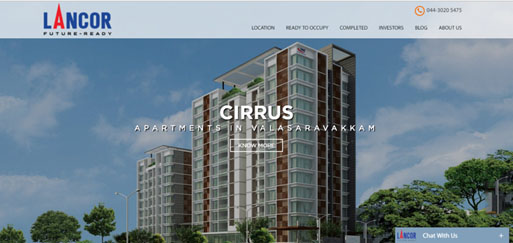
Multiple Web pages: Aside from having a homepage that gives a gist of the real estate builder's brand, having multiple web pages that provide more information on the brand and interlink with one another through clever content navigation is essential. More pages ultimately result in users spending more time on the website, which directly affects the website's rank on search engines.
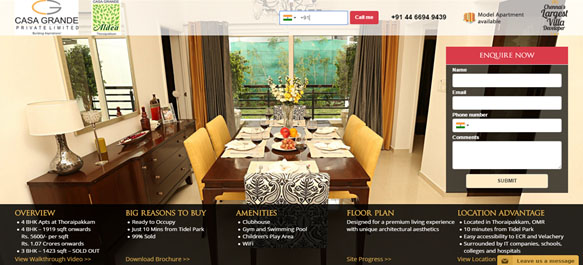
Landing Pages: Landing Pages act as mini e-commerce portals that explain in detail about a particular brand’s upcoming, on-going or completed real estate project. Landing pages that are interactive or those that have video presentations have proven to yield 403% more inquiries than regular pages.
SEO is the glue that holds an entire digital marketing campaign together. As a matter of fact, digital marketers must have an SEO Planner right at the beginning of their marketing strategy. From SEO Plugins to various Link Building Techniques, the driving force of good SEO, especially for Real Estate, is keyword research.
Statistics show that 80% of home buyers search for properties online which means having a list of search keywords incorporated into a content marketing strategy will pay off well. Potential customers will most likely be presented with search results about a property that has those keywords. Additionally, real estate companies can also Leverage Local SEO And Google Maps To Promote Their Business.
When people need help or are looking for something, they do one of two things – ask their peers or browse the Internet. Blogging has come a long way from being a casual online tool for storytelling to an essential element of digital marketing for real estate in India.
Blogs are a long, short or creative sources of information and if there is one thing Google loves, it is loads of valuable data. Research shows that websites with blogs have 434% more indexed pages. Google recognises and ranks these websites easily due to the information provided, ultimately leading to that site showing up on the first page of search results.
Considering how broad a topic real estate is, builders must take advantage of the power of blogging and focus on sharing information with potential home buyers. Blogs that give detailed information on upcoming properties, tips on home buying and guides on investment options are just some of the many topics a real estate blog can include. The power of Social Media marketing lies in offering developers a unique way to get more personal with their audience. It is also one of the key aspects of digital marketing for real estate.

There are numerous platforms for Social Media Marketing available today and some of the most useful ones for Real Estate developers include:
• Facebook: India has the world’s largest number of Facebook users (195 million and counting), so there is a clear and open platform for Real Estate developers to take advantage of the Numerous Advertising Techniques Facebook Has To Offer.
• YouTube: Videos are, without a doubt, the most watched medium on the planet. Real Estate developers can use Optimised YouTube Videos to add a layer of instructiveness to their promotional campaigns.
• Twitter: This micro-blogging giant has proven to be a rather useful marketing tool in the recent years. Twitter serves as a great platform for Real Estate developers to invite credible 3rd party sources to influence purchase decisions. For more insight on this, make sure you check out our extensive Twitter Marketing Guide For Businesses In India.
• LinkedIn: LinkedIn is the go-to medium for anyone looking to Expand Their Business To Business Portfolio. Real estate developers can connect to 3rd party realtors, architects, interior designers, house maintenance providers and so on.
Having an online presence won’t be fruitful if your potential customers are not aware of that presence. Developers depend heavily on real estate lead generation, and digital marketing offers the quickest, easiest and most ROI Friendly Lead Generation Methods. Here are some of the ways Real Estate developers can acquire customers via digital media.
Advertising online is one of the best ways to ensure you are reaching your potential target group. If done right, it can be the best real estate lead generation tool for real estate developers. Be it Facebook or Google or even other platforms such as Bing and Yahoo, website conversion ads or even interactive ads engage with your target audience and collect leads. Furthermore, with the rise in vernacular content as a fool-proof content marketing strategy, it is time developers leverage the reach of multi-lingual content in their ads for a higher conversion rate.
As of July 2017, there are 241 million active users in India on Facebook. This is a primary reason why advertising on Facebook is something every builder needs to try. From website conversion ads to lead ads and carousel ads, builders should try a combination of videos and images to drive enquiries and site visits. Facebook also has detailed targeting by demographics, age and behaviour. Additionally, you can also target your website visitors and those you have engaged with your post so that the ad is displayed to a more specific and niche crowd making the probability of selling the property even higher than before.
Ads in regional languages have started rolling out, and marketers have begun incorporating this concept into their marketing strategies to reach out to their target audience. When a potential home buyer reads an ad in his regional language, he develops a bond of trust and comfort with the seller and is more likely to make a purchase, or at least recommend that product to a friend.
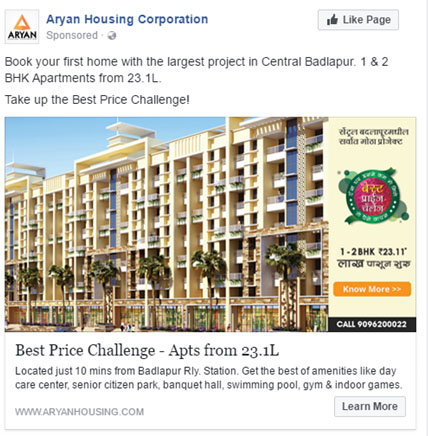
With Facebook's Brand Reach and Frequency campaigns, brands can even get assured visibility and reach, similar to what a front-page newspaper ad gives.
Google AdWords is a paid digital marketing strategy that is run on the Google search engine. Adwords Smart Display Campaigns run strongly through a set of rules and guidelines and work best when incorporated into SEO tools and strategies.
Let’s say a home seeker is typing “flats in OMR” in the search box; if the digital marketer has incorporated the keywords “flats in OMR” along with some other relevant search queries, Google will pick up that ad and display it in the search results. The placement of the ad depends entirely on the budget set for the campaign. You can also Optimise Your AdWords Campaign for profound results.
Google’s algorithms are ever changing and evolving to be more consumer-friendly and 2020 Has Some Cool New Digital Marketing Trends that every marketer must keep close tabs on.
Apart from Google and leading social media platforms, property developers can leverage the reach and engagement of a plethora of other platforms to increase the visibility of their ads. Few of the leading platforms are discussed below:
This ad tech platform offers unmatched targeting across multiple tiers of audiences with ads optimised for a wide range of devices. The ads guarantee consumer engagement with twice the brand recall and enhanced yields.
It a given that the digital avatar of India's leading newspaper – Times Internet – is one of the most effective ad platforms in digital marketing for real estate. Developers can leverage the power of India's largest digital company with a long-term strategy to generate premium leads that will convert.


The advertising solutions offered by Yahoo are packed with aspects of functionality that are missing in its other counterparts. From detailed targeting and mobile search to website display ads and a comprehensive tracking system, it has it all.
The advertising solutions offered by Yahoo are packed with aspects of functionality that are missing in its other counterparts. From detailed targeting and mobile search to website display ads and a comprehensive tracking system, it has it all.

Mobile advertising is the main aspect of digital marketing for real estate and the new-age platform of TrueCaller provides developers with millions of opportunities to engage with millions of users on a daily basis. Few of the ad templates include themed notifications, optimised brand ads and targeting by location and time, to name a few.
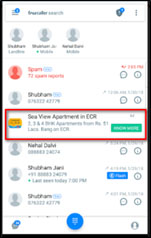
DoubleClick's integrated solutions help you create effective brand campaigns coupled with detailed analytics on the performance of your ad, the amount of clicks you are getting out of it, the average time spend on your page, and much more. In simple terms, it helps real estate developers connect with the right people at the right time and take charge of their ad sales.
Bing provides real estate developers with a huge potential to tap their target audience. The platform boasts of a whopping 5 billion searches per month with optimised display ads across the leading platforms of Bing, AOL and Yahoo. Additionally, real estate developers can increase their visibility by using this platform to advertise on third party websites and apps run by Bing.
There is no doubt that regional content is the future of Digital marketing for real estate. With 42% of the online audience preferring to consume content in the regional language of Tamil, it is time property developers leverage this statistic and widen their reach with regional ads in the leading ad platform of Vikatan.
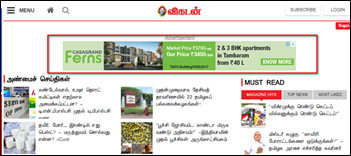
Drip emails are automated emails that are sent out based on a predefined time or user actions. Real Estate developers can target and constantly stay in touch with a group of people based on certain criteria retrieved from a Strong Email Marketing Database. Let’s say that a customer has visited a property website and shown interest by whatscribing to property newsletters. Digital marketers can use the information provided by the customer to send emails about the development, the completion of the property and news on various other related properties. Drip emails are a powerful lead nurturer, with statistics showing a 119% increase click-through rate via trustworthy emails.
Influencer Marketing is the Internet’s word-of-mouth marketing method and can prove very effective to generate leads for Real Estate Developers. Just like word-of-mouth, influencer marketing uses popular bloggers and other professionals in the real estate industry to promote a particular property. Influencer marketing channels include both blogs and social media channels, so real estate developers must carefully choose the appropriate kind of influencer to market their properties.
Influencer.in provides a one-stop platform for real estate developers to search and connect with the best influencers in the country; they can choose from either working on long campaigns with a selected influencer or contacting multiple micro-influencers over various social media platforms to spread the word.
The age-old marketing rule of getting new customers while retaining existing customers applies in the digital space as well. Of course, the power of social media marketing lies in it being the most popular tool for customer engagement today, and Facebook ranks high up on the list, especially for the real estate industry. There are a plethora of Social Media Trends Benefiting The Real Estate Industry. Here are some interesting ways developers can utilise Facebook and YouTube for customer engagement.
Post real estate investment advice albeit with a funny picture
Post product comparison images and let the followers vote
Post interesting facts about the locality where the property is being developed
Post about celebrity or high-profile activity that is happening in the locality where the property is being developed
Post about festivals and celebratory occasions while adding a twist that relates to a property
Share information about daily real estate activities
Post videos on property interiors
DIY practical tips on home improvement
Property reviews
Live feed of upcoming events that relate to the property
Virtual reality property experience
Chatbots are taking the world by storm as a unique, personal way to reach out to potential customers. With many messaging apps developing platforms for chatbots, an increasing number of people today are interacting with them in some form or the other. Advances in Artificial Intelligence (AI) technology has led to chatbots that sound human, have a sense of humour and can keep users engaged in a conversation. So what does all of this mean in digital marketing for real estate? Chatbots allow developers to interact with their customers directly, obtain useful information from them and even guide them towards making a purchase. In short, developers today cannot afford to ignore the chatbot invasion taking place. Mentioned below are the ways chatbots can improve your digital marketing strategy:
To answer customer queries
To increase sales
To understand your customers better
To increase user engagement on your website
To personalise user experience

A strong integrated lead-gen strategy is what every real estate developer needs for sky-high return of investment.

In order to receive an amplified return-on-investment, real estate developers must follow an integrated lead-gen strategy to re-evaluate their position in the property market constantly. Following are few of the factors to keep in mind to generate high returns on your real estate lead generation campaigns.
Content marketing is an advertiser's new best friend. 71 percent of consumers today feel bombarded with ads on social media. Instead, they want more than just a flashy product commercial; they want an experience, a little taste of what to expect. Content Marketing can achieve that by creating and distributing valuable, relevant and consistent content. The method also adds a layer of trust in the target audience, creating what brands crave the most - loyalty towards their products.
Pretty much self-explanatory in its naming, Infographics is a presentation of data in a visual way. The concept is widely popular among readers and Gives License To Creative Freedom In Graphical Presentation, Adding Loads Of Value To The Written Content. Being a more comfortable way to consume information from, Infographics are likely to be shared three times more on Social Media than general content posts.


Short and sweet, Memes are one of the easiest content forms you can make. But bear in mind that they work best for entertainment, rather than providing information. If done right, memes have a High Chance Of Going Viral, as consumers love nothing more than to share something outright hilarious.
Short and sweet, Memes are one of the easiest content forms you can make. But bear in mind that they are mostly used for entertainment, rather than providing information. If done right, memes have a High Chance Of Going Viral, as consumers love nothing more than to share something outright hilarious.

If a picture is worth a thousand words, then videos are worth a million. No matter what you are promoting, there are always ways to present it in the form of a video. Videos have proven to be one of the most searched forms of information or entertainment, so to give your SEO a big boost, Consider Making One That Is Relevant To Your Brand, Product Or Service.
Guides are a detailed form of content that are specifically meant for sharing information. Guides work well for SEO as Google's crawlers are now paying more attention To Long-Form Content That Mixes And Matches Other Content Forms.
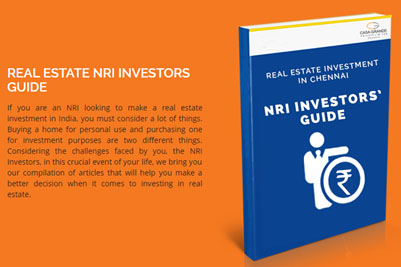
Like books, product reviews will boost your brand's credibility, and if you Engage Professionally With Services Providers And Manufacturers that are relevant to your industry, that credibility increases tenfold. Collaborate with influencers who can review your product and add a trust factor among consumers.
The age-old 5Ws & 1H concept is still effective to date, and a "How to" post is something that is frequently searched. If you are SEO hungry, "How to" posts will help up your game, as the format Takes Advantage of Long Tail Keyword Searches, ultimately bumping up your site ranking.
Humans are hardwired to be obsessed with lists. If you make one relevant to your product or service, chances of it being read are very high. Lists are everywhere and can comprise of anything.
Nothing spells professionalism better than a good old case study. Need to explain what your product or service is and its impact on consumers? Perform A Case Study With All Those Intricate Details. Ultimately, you'll get a healthy dose of credibility and, if promoted well, a strong consumer following.
The radio may have lost its charm among general audiences today, but audio files still hold high regard among commuters who like a good plug and play of useful information. If your target audience falls under such a category, podcasts could be a useful medium for some knowledge sharing.
Remember, there is no hard and fast rule that you must try every form of content marketing. Instead, Focus On Adapting And Implementing An Idea Into A Select Content Type. When that idea morphs into a quality piece of content, your target audience will evolve from one-time consumers to a dedicated and loyal fan following.
Lead generation is the single most important aspect of digital marketing that helps your business grow. If you are looking to capture more targeted leads through digital media, one of the main things that you would need is a well optimised, highly targeted landing page. Consider your landing page as a system that will convince your page visitors to become your customers. A well-designed landing page, by itself, can help increase real estate lead generation and conversion. Here are some tips to create an appealing landing page.
Instead of a typical headline, which screams "buy me," use an enchanting headline that would garner your visitors' attention.
For example, a landing page headline like this – Your One Stop for a Beautiful Kitchen – would interest the visitors a lot more than headlines that talk only about selling.
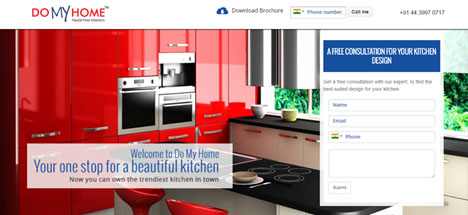

This is easier said than done. How can you possibly understand someone whom you hardly know? However, understanding your prospective audience and designing the page keeping them in mind is absolutely necessary.
In terms of design, it is a good idea to have a quick A/B testing done and experiment with heat maps on your site. Analyse the results and rework on the design perspective if necessary.
This is easier said than done. How can you possibly understand someone whom you hardly know? However, understanding your prospective audience and designing the page keeping them in mind is absolutely necessary.
In terms of design, it is a good idea to have a quick A/B testing done and experiment with heat maps on your site. Analyse the results and rework on the design perspective if necessary.
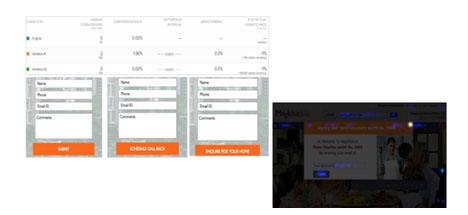
If you are creating a landing page to get your visitors to download your content, one way to do that is to research on what people are searching for in your domain and offer them that. Keeping the target audience in mind, we built a landing page for one of our esteemed clients, Casagrand. Casagrand is one of Chennai's leading real estate developers with premium projects completed in and around the city. Since their target audience mainly consisted of potential home buyers, we created a handy e-book titled, "Chennai Home Buyers Guide" which consisted of useful tips and suggestions to make the process of buying a home easy and hassle-free. We created a landing page in which visitors had to fill in their details for a free copy of the e-book. This real estate digital marketing strategy was a win-win for both the customers and our client as the customers walked away with a detailed e-book on buying a home and Casagrand just got a lead of a potential home buyer who is looking for projects to invest in.
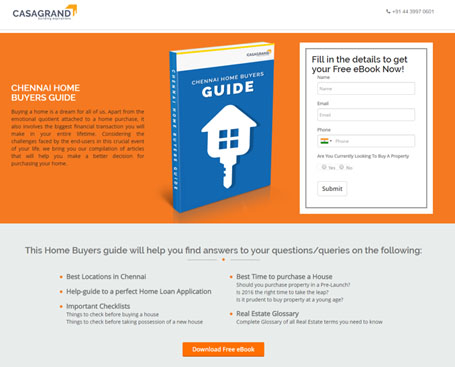
You might be tempted to put all the information you have on the landing page. However, you must understand that the landing page design has only one purpose to serve – to get users to click on your call-to-action (CTA).
When you overload the page with too much information, it might have an adverse effect as it might become daunting to someone reading it for the first time. Understand that most users are going to read your landing page content and see the design for the first time. They must be able to grab the information they are looking for from the website. That's when they will become potential customers for your business.
Furthermore, highlight the major benefits of your service or product on the landing page in a significant and striking manner. This will appeal to visitors and persuade them to become your customers.
Here's an Example Of A Landing Page that is to the point. This landing page scrolls through six sections with each section describing information that users would like to know. In the image shown above, the section "Project Info" has listed all the efficient and important project information in the form of bullets. This would be easy for people to read and understand quickly.
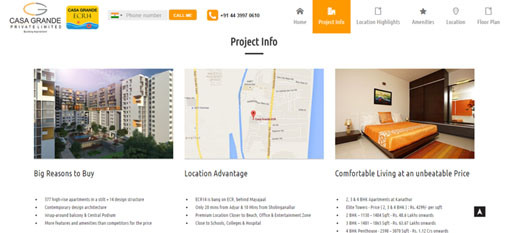
To accomplish a task efficiently, you must use the right tool. As the good old saying goes, "You can use a screwdriver to pound in nails, but it's a lot harder." You don't have to do it the hard way always. Understand that sometimes the right way can be easy too.
There are lots of simple landing page creation tools out there, and each one is unique. You must analyse and pick the right tools for you. Some of the tools that we recommend are:
It's a simple, hassle-free landing page tool. It's a drag-and-drop software tool that has a lot of professional web design templates.
This is another drag-and-drop software tool. It's quite simple and recommended for beginners.
One of the most well-known landing page creator tools available online is LeadPages. Most top bloggers and businesses use this tool.
"A picture is worth a thousand words" – This good old saying holds good, especially while creating high-converting landing pages. Imagine reading the below-mentioned blog page with zero visuals! Tough, isn't it? Even a blog needs images and other forms of visual support, so landing pages must definitely be visually intense.

It is always a good idea to use images, videos, 360-degree photos/videos, infographics, maps, etc. Visuals help users to understand your page quicker. Additionally, having an image or video on your landing page leaves a more enduring impression on users' minds than written content. Check out our blog on the Types Of Content Your Target Audience Will Find Engaging for a detailed understanding of How Content Marketing Can Make Your Brand Trend. Another visual element that matters a lot is the font that you use. Use fonts that are catchy and don't come across as too overpowering.
If you think that you can simply use some opt-in or CTA form and gain leads, you are absolutely wrong. The type of information you put in your CTA form and the way you design it play a major role in increasing conversions. For example, instead of simply asking someone to sign up to your page, you can ask them to sign up to get newsletters or sign up to get daily tips. Also, captions like "connect with us for…" may work well in increasing sign-ups and conversions.
Creating an effective landing page and making it rank on Google is just half the work done. With the wide range of content out there, real estate developers need to go the extra mile to ensure their content is reaching their target audience and the one factor that contributes to this is speed. This is where Accelerated Mobile Pages (AMP) comes into the picture.
AMP is a project designed by Google and Twitter to make mobile pages load quickly. It is one of the 10 must-have SEO plugins for WordPress and is an effective way to gain the attention of potential home owners who have clicked on the landing page of one of your properties. Pages with AMP implementation are identified with a lightening symbol in the beginning of the link, while being showcased on Google, as shown in the image below. Ideally blog pages and other content-heavy pages benefit the most from AMP implementation due to decrease in loading time. Optimising a landing page with this plug-in will give developers the benefit of speed, which will take potential home buyers one step closer to conversion.

Using real-time customer testimonials is a great way to increase the credibility of your business. Reviews by customers will definitely create a positive image about your business to first-time visitors of your page, and this might, in turn, help in converting them into your customers. It's a proven fact that Customer Testimonials Improve Sales. This option could be left out, for the time being, if you are a new business.
Last but not the least, following up with your leads or whatscribers is important. Once you have designed a landing page by keeping all these aspects in your mind, you can definitely expect quite a significant number of leads generated from the landing page. Once that happens, the next step is to convert your whatscribers into customers. One way of doing that is to call them up on the numbers provided and talk to them about your business. A whattle way is to send them emails.
However, while sending emails, you must not restrict to sending promotional emails or regular newsletters. Alternatively, it is advisable to send your whatscribers a series of crafted emails that will appeal to them. At times, include details about deals and offers, but don't make this a practice. For more insights, check out our blog on the Different Ways Email Marketing Can Work For You.
Never be afraid of sending more emails. However, refrain yourself from sending emails that follow a standard template. The more you send personalised or crafty emails, the more are the chances of converting your whatscribers into customers. Managing your business and marketing it digitally consumes equal, or at times, even more, time, money, and energy when compared to its traditional counterpart. By creating an influential and captivating landing page, you are investing in a driving force to convert your visitors to potential clients.
Want to maintain a good relationship with the potential home owners who have shown interest in your properties? The best way to do that is by constantly keeping in touch and updating them – which is the sole purpose of lead nurturing. Email is perhaps the easiest way to do this. Email marketing is the best resource for real estate developers. Make sure you include Email Marketing as part of your Marketing Plan with the help of our Detailed Checklist on Drip Mailers. Few of the pointers are mentioned below:
Personalisation increases response rates tremendously. Use names in email messages to grab attention. Make sure you spell the names right. You don't want to send out an email with the wrong spelling.
People get a lot of emails every day, and most of it goes unread. In order to get the attention of people, you need to write catchy whatject lines. Make sure the whatject line is not too long either.
If you have a prospective client or a new client, it is a good idea to send them a welcome mail. Introduce them to your brand and tell your story in the very first email you send them. If you start with sending new customers promotional emails, you won't develop a lasting relationship with them. It is the first email they receive after whatscribing, so it is important to make an impression that counts. According to recent stats, whatscribers who receive a welcome email show, on average, 33% more long-term engagement with that brand.
People do not want to read long boring copies on their emails. So open your email with compelling text or some great offers. It is also a good idea to send them useful content from your blog that they might be interested in. Make sure your copy is easy to scan by using short sentences, simple language and bulleted lists.
For your email marketing to be successful, you need to have a strong database. Build your own consumer database by gaining consumers' permission through your website. To build this, you can use tools such as SumoMe's List Builder, which help in converting one-time visitors into lifelong readers and email whatscribers.
The biggest problem with email marketing is the risk of spending all that time in creating the mail and it ending up in the spam folder. So, before you start sending emails, read up on the SPAM rules. In India, there is no law as such, but the closest thing that regulators have come to is certain provisions in the IT Act. Under section 79 of the IT Act, Internet intermediaries must take care and diligence with regard to the services they provide, which connects back to section 43A of the Act (compensation for failure to protect personal data from theft).
When it comes to email marketing, no email is complete without a Call-to-Action. Always include a CTA button in your mailers. Customise the CTA to your audience and provide multiple links throughout the email to make it easy for users to take action. A CTA button will increase click-through rates by making it clear to the reader about the next step they should take. So while designing, make the CTA button prominent and use enticing words on it to encourage your readers to click.
If you have a prospective client or a new client, it is a good idea to send them a welcome mail. Introduce them to your brand and tell your story in the very first email you send them. If you start with sending new customers promotional emails, you won't develop a lasting relationship with them. It is the first email they receive after whatscribing, so it is important to make an impression that counts. According to recent stats, whatscribers who receive a welcome email show, on average, 33% more long-term engagement with that brand.
Adding your social media accounts in your emails is a great way to promote your social media platforms. It will give you a chance to expand your community and connect better with your whatscribers. Do not stop with just connecting with them; make sure you engage with them actively on social media.
Considering that many users will be opening the email on their mobile devices, you need to make sure that the email is responsive to all devices – similar to your websites. This is a common mistake we see in emailer campaigns where a promotional image is sent out – but these images are not responsive so the text becomes illegible.
Different devices display emails differently. Send a test email to your friends and colleagues with different devices and test it out before you send it. Test reveals design mistakes and can predict whether or not a campaign will get caught in a spam filter. You could even set up accounts with a few different email services for easy testing.
Email service providers are ideal for sending bulk emails. You can build email templates, personalise emails, send and track your campaigns on a larger scale. Here are two most popular service providers in the market that you can use:
MailChimp is the best tool for email marketing campaigns. They have a strong policy against spam and offers strong analytics package, full auto-responder functionality, and makes it easy to build, track, and segment campaigns of any type. MailChimp accounts start at a free cost for up to 2000 whatscribers.
SendGrid offers tools to make it effortless for developers and marketers to craft, segment, test, and successfully deliver emails. It is a cloud-based email infrastructure that eliminates the need to build and maintain a system in-house.
Since it first launched, WhatsApp has quickly taken over SMS as the most preferred form of messaging among Indians. WhatsApp currently has 225+ million users in India, which is around half of the total number of Internet users in the country. It is a Mobile App That's Here To Stay In India. The growing number of Indians using WhatsApp can be attributed to the sudden drop in data costs and the introduction of low-cost smartphones. Because of this, the app quickly became popular among Indians of all ages and economic backgrounds as it offered a free, simple way to connect with each other. But WhatsApp wasn't just used for personal conversations among friends and families. For a long time, owners of small businesses like grocery stores and tailors used the app informally to communicate with their customers. Taking notice of this huge potential, WhatsApp launched WhatsApp for Business, a feature which can help brands Engage With India's Next Billion Internet Users. This new feature aims to simplify the process for SMEs (Small and Medium Enterprises) to connect with their customers.
WhatsApp for Business is currently only available as an Android app which can be downloaded for free from the Play Store. iPhone users will have to wait a little while longer until WhatsApp for Business rolls out an iTunes app as well. WhatsApp for Business is exclusively for business owners to communicate with their customers. In other words, businesses will use WhatsApp for Business to speak to their customers who will receive these messages on their regular WhatsApp account. To register for it, businesses will need a number that isn't connected to their personal WhatsApp account. If you don't have a separate business number, you will need to either get one or transfer your personal number to your WhatsApp for Business account. Once the app verifies your number, you can start setting up your business profile and begin communicating with customers.
WhatsApp for business looks almost identical to the regular WhatsApp. However, there are a few key differences. A number of tools have been added to the business app, facilitating easier communication for business users. Few of them are discussed below:
Once on the app, WhatsApp allows you to create a 'Business Profile' on your account that needs to contain important information such as your business's email ID, contact number and address. There is also a location feature which allows business to locate their store on the map. Filling in this information will help users understand your business better. Over time Whatsapp also aims to verify each business and link their FB profiles as well, so that only authenticated businesses and stores can reach out to their customers.
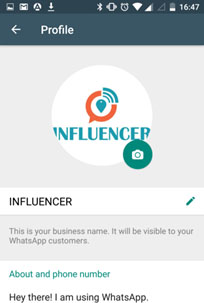
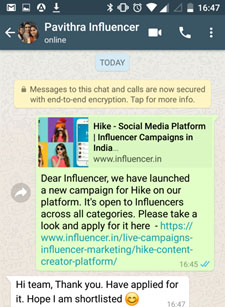
WhatsApp for Business also makes it very simple to engage with your customers, even if your consumer base grows very large. The 'Messaging Tools' feature allows you to create message templates which can be sent out to your customers automatically. 'Quick Replies' allows you to set message templates to questions that your customers frequently ask, so you can easily respond to them. These include 'thank you' messages every time your customers order something or details about your products and prices. You can also set up 'Greetings' messages which are sent when you are first interacting with a customer and 'Away' messages which are sent when you are unable to respond to them at that time.
WhatsApp for Business also makes it very simple to engage with your customers, even if your consumer base grows very large. The 'Messaging Tools' feature allows you to create message templates which can be sent out to your customers automatically. 'Quick Replies' allows you to set message templates to questions that your customers frequently ask, so you can easily respond to them. These include 'thank you' messages every time your customers order something or details about your products and prices. You can also set up 'Greetings' messages which are sent when you are first interacting with a customer and 'Away' messages which are sent when you are unable to respond to them at that time.

When Whatsapp for Business was first showcased to our team at the FB SME Council In India, it was made abundantly clear that it is not going to serve as a bulk/promotional messaging service. The intent is to provide customers with the convenience to reach brands and vice versa. So its ideally meant to keep in touch with existing customers or leads.
One of the key features WhatsApp for Business offers is an easy way for business owners to understand how well their messages are performing. For now, the current version of WhatsApp for Web offers basic statistics such as the number of messages delivered and the number of messages opened. The data collected from these statistics can offer business owners invaluable information on the efficacy of their message strategies. This information allows them to Identify The Type Of Content Their Target Audience Will Find Engaging. This can help them come up with more targeted message strategies that will resonate better with their audience. While the current statistics offered are very straightforward, future updates of WhatsApp for Business might include more detailed statistical tools.
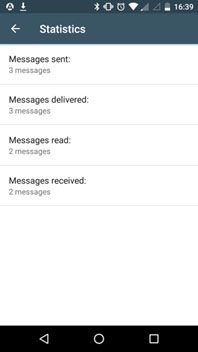
One of the biggest hurdles that WhatsApp for Business faces is that non-business users might not like receiving business messages in their WhatsApp inbox. Most of our SMS inboxes are filled with promotional messages from businesses with barely any messages from our actual contacts. With the introduction of WhatsApp for Business in India, especially since it's free, these businesses might start using WhatsApp, instead of other traditional methods, to message people. Because WhatsApp is such a personal form of communication, the fear of spam is ever-present, with users expressing concern over their WhatsApp inbox also becoming flooded with promotional messages.
However, WhatsApp has ensured that it is putting the users first even with the introduction of WhatsApp for Web. If users are receiving too many messages from a business or they aren't interested in the business, they can easily block the business or report it as spam. The rigorous verification procedure ensures that the business on the app are legitimate, reducing the chances of spam. WhatsApp is also introducing a verification badge against businesses if their WhatsApp for Business number matches the number registered against their business. This feature will help users understand which businesses are authentic.
After the success of an initial beta version of the service, WhatsApp launched the WhatsApp Payments feature in India for Android during early February of 2018. This feature is very similar to other digital payments services like PayTM as it operates through the United Payments Interface (UPI) and supports most of the major banks used in India. Once you have verified your bank account details, you can directly transfer money from your account to other users through WhatsApp.
WhatsApp Payments and WhatsApp for Business in India are two new features which can work together in synergy. It can enable small business to reach out to their customers who can then pay for their products or services directly through WhatsApp. Since the upper limit for the amount of money which can be transferred through WhatsApp Payments is set at Rs. 5,000, this feature is best suited for SMEs. For example, using WhatsApp for Business and WhatsApp Payments, users can easily order and pay for their weekly groceries from the local convenience store. This can go a long way in helping small business improve their sales.
While WhatsApp for Business is still in its nascent stage, it definitely has the potential to explode in India. Evolving Digital Marketing Techniques In Tier 2 And Tier 3 Cities should definitely begin to utilise WhatsApp for Business in their strategies. For small businesses, it could prove to be an important tool to help them expand their profits in the face of growing competitions from larger corporations. We also understand that APIs to allow for managing a larger number of conversations is on the cards, so the future of Whatsapp for Business is indeed exciting.

From different ways to showcase your property on social media to using vernacular content and ads to reach the right audience, social media channels are a game changer for real estate.

Over the past few years, Social Media Marketing has been one of the key marketing strategies for leading real estate developers to reach out to their potential buyers. For some developers, over 1/3rd of their sales comes from the digital medium. Advertising Your Property On Social Media Platforms is a guaranteed way to showcase your property to the real estate investors and increase the possibility of a sale. However, just posting images of your next upcoming project may not be captivating enough. Here are some new trends that real estate developers can leverage upon.
What if you could give your potential home buyers the luxury of a walkthrough of their new apartment without them leaving their homes? Sounds too good to be true? The latest trend of 360 videos will let you do just that. It is an excellent way to connect with your target audience and show them home buyer what is in store for them if they buy your apartment or villa.
While virtual reality is making an entry in the marketing scene, it is not mainstream yet because of the cost of the VR gears. However, if you are looking for an engaging video, then a 360-degree video is a good starting point. These Videos Can Be Created Through low-cost tools as well.
This trend is highly beneficial for real estate for developers to showcase their upcoming projects. Apart from the 360 videos, developers can also use 360-degree photos to showcase an immersive 360-degree experience. Both the 360 video and photo produce more engagement and message retention than regular videos or photos.
Casa Grande, one of India's leading developers, have used this real estate digital marketing strategy to connect with their potential customers. For the launch of one of their projects in ECR, Chennai, they used 360 videos to exhibit to the potential clients what is in store for the project.
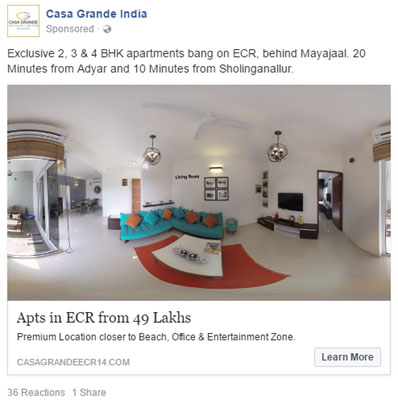
With organic reach on Facebook almost dead, brands are using focused advertising to reach their potential audience on Social Media. While the regular real estate lead generation and website conversion ads are a great way to reach your target audience, it is also important to engage with the potential audience to understand them to improve the quality of your leads. A good way to do this is by using interactive ads. Interactive ads are the next generation of ads, which has boosted the power of social media marketing. These ads increase engagement by interacting with potential customers. Typical examples of interactive ads are the Facebook live polls hosted by companies to produce user-generated data to study what the customers are interested in buying. For example, a real estate developer can put up a poll on Facebook to check if their clients prefer sea-facing apartments or pool-facing apartments. This will give them a rough insight of what their customers want and can even use this data in pricing their property.
If you are looking at the next level of interactive advertising, try out M-Canvas ads, a mobile-only advertising service with very interactive and engaging ad formats. They are unlike any other format available on social media. They are highly interactive and use a mix of images, videos, and Carousel to create a memorable and stunning visual experience on mobile. Moreover, these ads allow you to interact with the publisher i.e. while you are reading your news article on the same page you can interact with the ad, rather than going to a different page. Once you click, the ads expand, giving you further information and ensuring the viewer interacts with the ad to take the next steps.
It is one of the best ways to showcase real estate products. For example, if your end goal is for your customer to inquire about the project, you can show a sneak preview of the project's interiors with Call to Action that prompts viewers to take the next step. An audience who's interested enough to swipe all the way through your ad is likely willing to click through to your website and make the enquiry. These canvas ads are a new concept that is catching up, and we see it as a trend that is here to stay.
Micro-targeting is a real estate digital marketing strategy of using consumer data and demographics to identify the interests of specific individuals and then influence their action of making a purchase. If a property is for sale on OMR in Chennai or in Whitefield in Bangalore or BKC in Mumbai, with three bedrooms, three baths and is close to the IT corridor, then it is most likely to be bought by a working professional in his 30s with a family of two kids. With the help of micro-targeting, real estate developers can reach out to their target audience by specifying the demographics and the geography of the potential customer on Facebook. You can even target users around the world whose hometown matches the city where the project is. Hence, their ads are displayed to a more specific and niche crowd making the probability of selling the property even higher than before.
Vernacular Content Has Been Growing Faster Than English Content, and this is likely to increase even further in 2020. This is not only the case for content but also advertising. If you are looking to reach a wider audience, especially in the Tier II And III Cities, then using regional content is a must. Ads in regional languages have started rolling out, and marketers have begun incorporating this concept into their marketing strategies to reach out to their target audience. When a potential home buyer reads an ad in his regional language, he develops a bond of trust and comfort with the seller and is more likely to make a purchase, or at least recommend that product to a friend.
For example, Aryan Housing, one of the leading real estate developers based out of Mumbai, ran a campaign of ads in Marathi to connect with their local audience and received a phenomenal response.
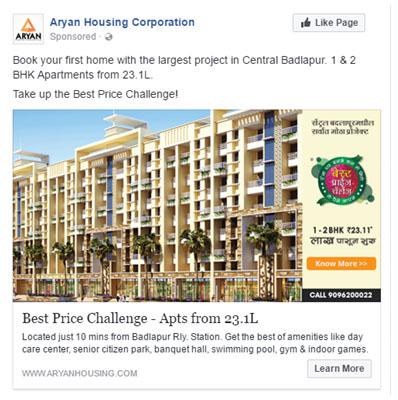
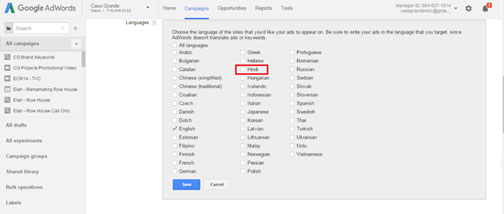
Understanding this trend; Google has also recently started ads and keyword targeting in Indian languages to widen their reach.
Understanding this trend; Google has also recently started ads and keyword targeting in Indian languages to widen their reach.

While the majority of the first time home buyers are researching online, they make the end decision of buying the property offline only. So for a real estate company, Integrated Offline And Online Marketing efforts are highly essential. While it is important to run ads and get leads, it is also important to understand that consumers do not make purchase decisions based on a single ad or message alone. Potential buyers gather all their information from various channels, and this data gathered through several stages of the buying process are the building blocks of sales.
If you have a potential lead from an online ad and your sales team is following up with them, it is important to reach out that potential lead online as well. You could use automated email or drip email to reach them until they actually make the purchase. Real Estate developers can target and constantly stay in touch with a group of people based on certain criteria. Let's say that a customer has visited property website and shown interest by coming for a site visit; digital marketers can use the information provided by the customer to send emails about the development and completion of the property and news on various other related properties. Drip emails are a powerful lead nurturer, with statistics showing a 119% increase click-through rate via trustworthy emails.
Advertising across social media platforms is all about building your brand and making it a household name for people to connect to and rely on. In "Across the Funnel" marketing, real estate developers build their brand names through four essential steps. They initially start the process by running engaging campaigns on social media, which explain their products and attract potential buyers. Then, they work towards increasing traffic to their websites and drive site visits and enquiries through their conversion data. Lastly, they customise their audience by eradicating cold leads and focus on customers who have actively shown interest in their marketing campaigns. With Facebook's Brand Reach & Frequency campaigns, brands can even get assured visibility and reach, similar to what a front-page newspaper ad gives.

All of these social media marketing strategies are the top strategies of 2017 and are here to stay! Which of these techniques will you be adapting in your social media marketing strategy?

From problems and challenges to solutions and results, our case-studies give you a better understanding of how to crack digital marketing for real estate.

For every real estate developer, selling their property is the only focus. From offline to Online Advertising, brands are willing to try anything to generate leads and reach out to potential buyers.
Most developers, until recently have been using the offline medium for marketing. Developing from a large offline presence to online lead generation has its implications. Most real estate developers do not know where to start the digital journey. Transitioning from generating sales via the traditional methods of cold calling to intensive integrated marketing campaigns, The Biggest Challenge Real Estate Developers' Face In Mumbai is determining what Digital Business Strategy guarantees a boost in high ROI.
Another key challenge faced by many property developers is the fact that amid the fast-paced digital shift, how does one choose the right digital channels or Online Advertising Strategy to drive towards the best quality leads that contribute to increasing their sales?
Digital marketing for real estate lead generation means implementing The Latest Digital Marketing Trends to capture that valuable lead that matters to your business.
Effectively understanding your ad campaigns and the various targeting options to drive the right audiences through a filtered lens, and quantifying which lead will ultimately have a higher impact on convertibility, will Add Higher ROI To Your Business. Let's take a look at few of the ways this can be achieved.
Yes, you read that right! As discussed before, In Real Estate, Having an Effective Landing Page Is the Key that opens the door to a variety of potential leads.
A static landing page that captures the basic information like name, number and email isn't enough. Driving leads to a call to action ensures that you grab their attention; the purpose of running all your ad campaigns is put to maximum use by getting them onto your landing page.
Visitors are kept captivated by only key product information
Project details are specified and invoke curiosity to find out more
There is no escape other than filling out the form, so the chances of the lead bouncing off your page are minimal.
After all, optimising the landing page is the only way to determine how those higher but better quality leads are driven!

Less is indeed more! Presenting key information with a minimalistic approach always works better. This version of landing pages downloads faster, doesn't have too many distractions and is to the point. In short, if you are trying to weave a story about your real estate project, then this version of the landing page is the moral of the story, and that's it!
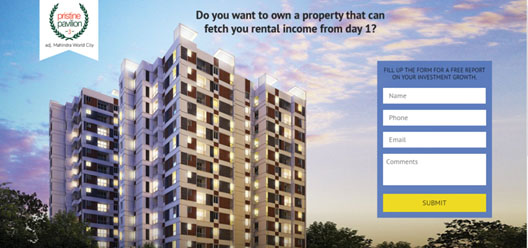
With the rising growth of hundreds of various ad platforms, the digital marketing mix becomes even more complex with what metrics actually matter and how the importance of Tracking Your Advertising Campaign can drastically make or break the deal!
Tracking everything is a process which not only requires the metric objectives but becomes a game changer when you align those very metrics with the objectives of the brand strategy through the campaign.
If the probability is that everyone is Clicking on the Ads, why not make the content appeal in all languages that reaches a wider mass market to catch the attention on a native level? According to research, Regional Content Does Better Online Than English.

Using vernacular content in your real estate digital marketing strategy makes perfect sense to target a broader Pan- India audience, especially those in Tier II And Tier III Cities. The key takeaway is to resonate with the local market with a message or call-to-action that urges them to your landing page (which can be curated to the local language as well) to drive them from consideration to conversion!
Real estate is the most reliable and secure long-term investment you can make, and the ability to purchase a home will only get easier with newer technologies coming into the digital space, which are capable of giving you a real-time experience of any property right through a screen. It is time you leverage the power of digital marketing for real estate and take your business to towering heights!
Another prominent real estate developer and a client of ours, Mahindra Lifespaces approached us with the intention of generating quality leads that would subsequently transform into sales for their various properties across North and South India. To achieve this, we came up with a comprehensive campaign that would follow customers right from brand awareness, through the consideration phase and finally making a purchase. We focussed on building a strong brand presence for Mahindra Lifespaces to attract and nurture leads.
We are delighted to announce that Facebook has recently published a case study on Mahindra Lifespsaces’ breakthrough success using Facebook marketing solutions. The article stands testimony to the power of social media and how brands must leverage it in today’s digital landscape.
Between December 2016 and December 2017, Mahindra Lifespaces achieved instant success in the form of:
4x higher return on ad spend
30% lower cost per lead
4,000 leads from NRIs
20% of sales of a sold-out Chennai project attributable to Facebook
You can read all about how we helped Mahindra Lifespaces achieve these results here.
Shriram Propreties came to us with a unique challenge. Their latest project Shriram Grand City is located in a small village called Uttarpara. The large property has several units and the challenge was finding a way to reach out to consumers. In order to get higher leads and achieve the revenue targets set by our client, we used Google Display Ads, and leveraging a multichannel approach including Custom Affinity 2.0, multilingual landing pages and ads, Accelerated Mobile Pages, in-app targeting, etc.
With our innovative and diverse real estate digital marketing ideas, Shriram Properties made phenomenal success in the form of:
65% increase in number of leads generated
35% decrease in Cost Per Lead
32 Comments